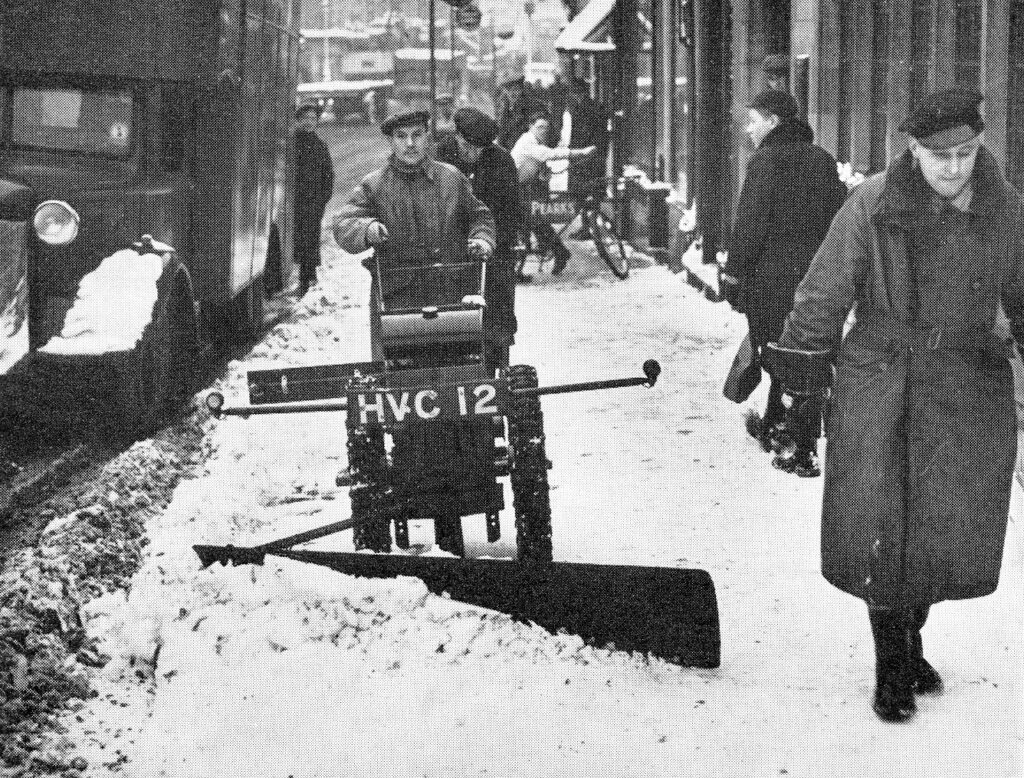
Historian and CovSoc Committee member, David Fry, has been studying past editions of the Alfred Herbert Newsletter. These newsletters are much more than just a works newsletter and reveal a lot about the thinking in the city at the time they were written. The article below is extracted from 1956 editions of their Newsletter, looking back at a year of activity in the busy post-war city, and is written in the words of the Alfred Herbert’s employee. David writes….
The changes to the city centre continue… Owen Owen’s new store plans for the cathedral and the first Lady Godiva Pageant since 1936…
And so, after perhaps the best Christmas since the war, Coventry looked forward with confidence to a ”Happy and Prosperous New Year”, for unemployment was a thing of the past—indeed the number of jobs exceeded the extremely low number of unemployed by 800.
Only one incident marred the quiet of January. On the 16th Alderman Fred Lee, the “Father” of the City Council, passed away at the ripe old age of 82. Alderman Lee, who had been Mayor of Coventry three times, was a greatly loved and highly respected Coventrian, and his death was a great loss, not only to his many friends, but also to the city.
February came in amid the snow and bitter cold of winter weather and the heat of a Parliamentary election campaign.
On the 8th, the Prime Minister, Mr. C. Attlee, addressed a Labour Rally in the Central Hall, while a few days later Mr. Anthony Eden spoke to a Conservative gathering in the same place.
When, on the 24th, the results of the previous day’s elections were announced it was found that although the Labour Party had been returned to power it was by such a slight majority that its position was pre-carious from the start.
Coventry again returned its three Labour candidates.
On March 17th a bitter pill was administered to the city’s ratepayers when it was announced that the rates, already standing at 17/6 in the pound were to be raised to 20/-. It is, of course, possible that the coincidental opening of two new schools, the Manor Park in Cheylesmore and the Henry Parkes in Canley, acted as a slight palliative to this unwelcome and, as many said, unwarranted dig into the ratepayers’ pockets.
It was during this month too that work started on the demolition of the shell of Christ Church. It was decided that the tower and spire should be left standing and the ground on which the church had stood be turned into a garden.
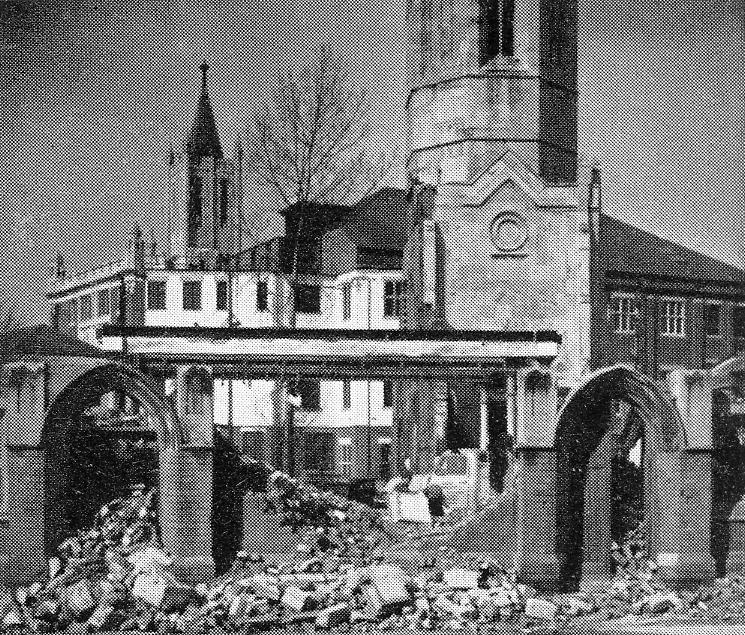
Another item of news regarding the rebuilding of the city came in May when it was announced that Sir Percy Thomas, Mr. Edward Maufe, and Mr. Howard Robertson would form the jury of assessors to judge the designs that would be submitted for the new cathedral.
The results of the municipal elections on May 11th showed that the Labour Party was still losing support all over the country for they lost over two hundred seats to the Conservatives. In Coventry, as in the Parliamentary elections, there was no change.
And yet more pleasant news. On May 27th petrol rationing came to an end.
Then like a bolt from the blue came stupefying catastrophe. The North Korean army had crossed the 38th parallel and invaded South Korea.
Once again the dread spectre of war stalked the earth.
With commendable promptitude President Truman flung down the gage and ordered the U.S.A. Services into action, and by the end of June U.S.A. and Commonwealth services, under the leadership of General McArthur, were engaged in fierce and bloody conflict.
And on all sides the fearful question “Can it be confined to Korea?”
On July 13th the three assessors met the members of the Cathedral Reconstruction Committee, visited the ruined Cathedral and studied the layout of the land around it, and on August 1st the terms of the competition were announced. There were to be awards of £2,000, £1,500 and £1,000 for the best three designs and the competition would be open for one year.
By the end of August rising international tension had reached such a pitch that all over the world re-armament plans were being feverishly discussed.
During September, which saw the holding of Coventry’s first Municipal Air Day at Baginton and the end of soap rationing, the U.N. armies forged slowly ahead and by the 24th came the heartening news that Seoul had been recaptured after some of the most bitter fighting of the campaign.
This was the last cheerful news of the year.
In early November it was announced that Coventry’s Civic Debt had reached the staggering total of £11,233,772. Hard on the heels of this financial bombshell came the disastrous news that 200,000 Communist Chinese troops had reinforced the North Koreans with the result that the U.N. forces were being hurled back everywhere along the line.
Early in December the mournful trend of world affairs was emphasised by the fact that the Prime Minister found it necessary to fly to America for consultation with President Truman.
Even the weather seemed to share in the general depression for on December 15th the whole of Britain was snow and ice-bound, main roads were blocked and the temperature in Coventry dropped to 24°F.
It was hardly the sort of weather to make householders take kindly to the order that, owing to the acute coal shortage, they would have to be careful in their use of fuel.
In spite of all this distressing news however, or perhaps because of it, the spirit of Christmas seemed very much in evidence and shopkeepers reported a lavish surge of spending such as had not been known for many years.
The New Year brought no easement either of the weather or of bad news. On January 2nd the country was blanketed by the worst snowfall since 1947; the 4th brought the news that U.N. troops had been forced to abandon Seoul, while the 5th brought such a rapid thaw as to cause serious flooding all over the country, so serious indeed that many main roads were impassable.
Then came a blow which concerned Coventry in particular.
On January 19th Sir Harry Harley died at sea while on his way to Australia. Sir Harry, who was 73 years old, was a well-known figure in Coventry. He had been born in Hillfields, and after spending his early working life at Alfred Herbert Limited had founded, in 1913, the now world-famous firm of the Coventry Gauge and Tool Co. Ltd.
His passing was greatly mourned in his native city.
By this time many of the citizens of Coventry were confined to their beds. Influenza, which for several weeks had taken a severe toll, showed a sudden drastic increase and 3,100 new cases were notified in four days. It must have seemed very ironic to the thousands of sufferers that the Ministry of Food should have chosen this particular time to cut the weekly meat ration to 8d. worth, the lowest ever.
Not that the Coventry Finance Committee were to be outdone for a few days later it recommended an increase of the rates to 22/- in the pound.
In addition to such misfortunes the fuel situation in Coventry had become really desperate and many householders were completely without fuel. As a consequence queues were forming at the Gas Works as early as four o’clock in the morning to get the meagre allowance of 28 Ibs. of coke.
It seemed that things could hardly get worse—or could they ?
On February 2nd 2,000 Merseyside dockers came out on strike, to be joined on the following day by another 10,000. By the 10th 19,600 were out and great fears were expressed in Coventry that a continuance of the strike would gravely jeopardise employment owing to the enormous stocks that were piling up.
Ice, snow and floods; hardly any fuel or meat; an influenza epidemic; was mass unemployment to be added to Coventry’s grim burden?
No, for suddenly it seemed that the Fates relented of their harshness and with bewildering rapidity once more changed the pattern on their looms.
On the 14th it was announced that the dock strike was over, and in Coventry came the further glad news that the epidemic was also over.
In March the Ministry of Works gave permission for the restoration of one of Coventry’s war-scarred jewels, Ford’s Hospital, after which the city busied itself with flags and bunting, for April 5th was to see yet another link forged in the long chain that had for centuries so closely united Coventry with the Sovereign of the Realm.
At 11.15 a.m. His Majesty King George, accompanied by Queen Elizabeth, arrived at Coventry Station. After being loyally greeted by Coventry’s leading citizens, they drove to Broadgate where they inspected the statue of Lady Godiva and then made a tour of Broadgate House, as the new Block B was now called.
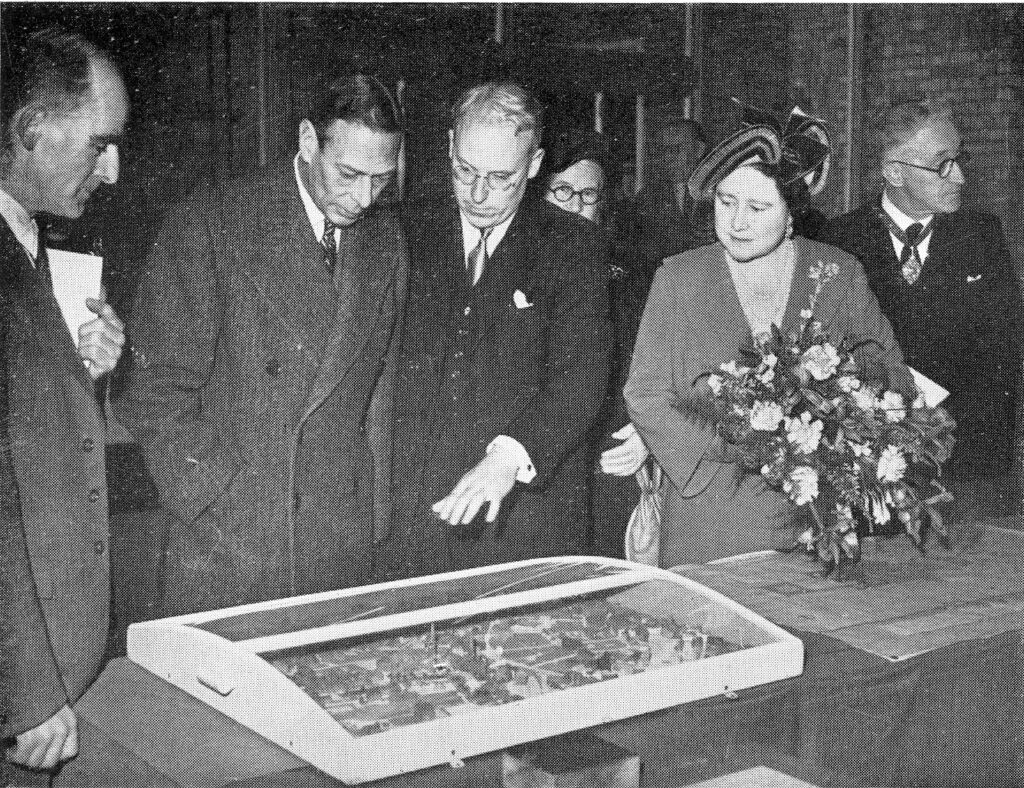
While they were there Their Majesties showed great interest in the model of the new city centre. They also saw the models for the proposed new Godiva clock, whereupon the King asked whether the Corporation did not think that it would create another traffic problem in Broadgate.
Vast crowds had turned out, in glorious sunshine, to greet the King and Queen on this all-too-short visit, and when Their Majesties left to visit the Ryton Police College they had a right royal send-off in the true Coventry manner.
A week later, details of the proposed new Owen Owen store were released—and a truly magnificent building it appeared to be. The front elevation to Broadgate seemed particularly impressive for it would have what was described as the largest window in Europe, 100 feet long and 40 feet high.
On the 14th yet more rebuilding was commenced, this time far from the city centre, when the Bishop of Coventry laid the foundation stone for the new St. Paul’s Church in Foleshill.
And still more rebuilding. On May 21st Hertford Street was closed to traffic to allow the framework of the new bridge, which was to span the street, to be erected.
Then came news that caused the entire nation sorrow, when it was learned that the King was suffering from an attack of influenza and a slight affection of the lung.
But perhaps it was only a mild indisposition for had he not, in a blaze of pageantry, opened the “Festival of Britain” less than a month before?
In Coventry the “Festival of Britain Week” commenced on Sunday, June 17th with a Civic Service in Holy Trinity Church. The celebrations continued all through the week, culminating on June 23rd with one of the most lavish Godiva Pageants ever presented.
The part of Lady Godiva was excellently portrayed by Miss Ann Wragg, a London actress, and the procession itself was 21/2 miles long, comprising no less than 60 tableaux with 2,000 performers taking part.
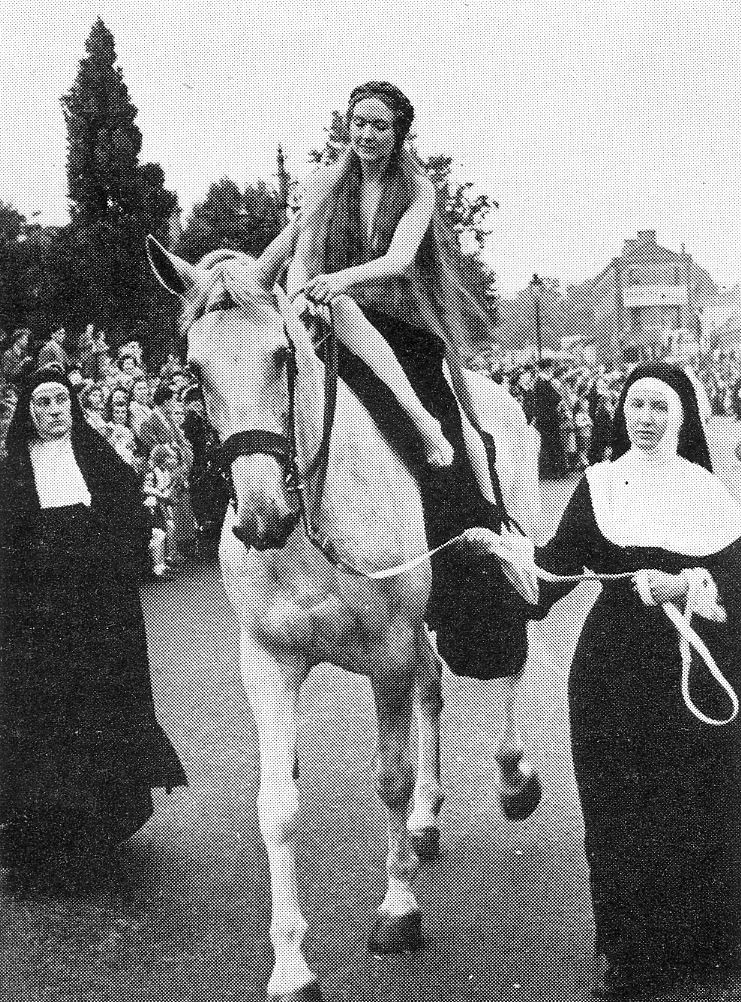
July opened with the extremely welcome news that cease-fire talks had begun in Korea. The month also provided further indications of the city’s huge rebuilding programme, for excavations started taking place in Cope Street for the new College of Art and Technology.
But an announcement by the Ministry of Fuel was not so welcome. On August 15th coke and similar fuels would be rationed, for “Britain faces the worst electrical shortage since the winter fuel crisis of 1947”.
Two days later came news of a very different nature that later caused great controversy in Coventry. The assessors of the Cathedral Reconstruction Competition had awarded the first prize to Mr. Basil Spence of Edinburgh whose designs they described as being of outstanding excellence.
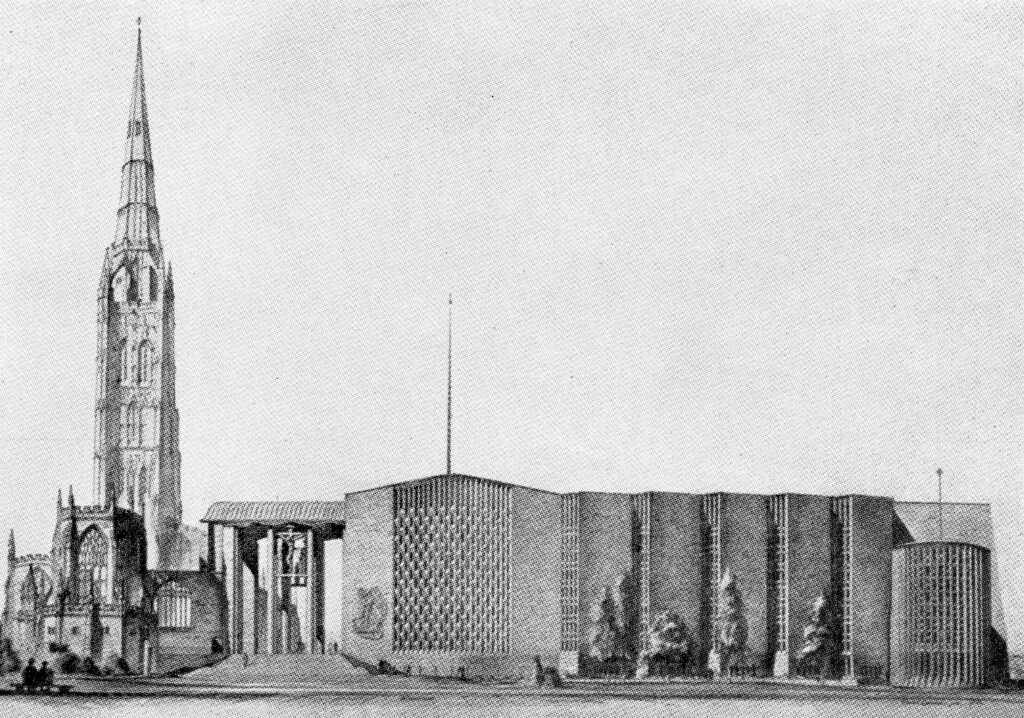
The reactions of the citizens of Coventry when they saw the designs were far from apathetic. “A monstrosity in concrete”, “A truly magnificent conception”, “A monument of ugliness”, “The inspiration of a visionary”. And the cost, £800,000. “Hundreds of houses could be built for that huge sum”, “Less than the cost of a bomber”.
To and fro went the arguments for and against the certainly very un-St. Michael-like design that had been adjudged the best.
But, interesting though the arguments were, there were wider issues that commanded attention.
By September it was learned that the cease-fire in Korea had broken down and fighting had recommenced, and on the 22nd it became obvious that the King’s condition was very much more serious than had generally been realised.
After examination by five doctors, an operating theatre had been set up in Buckingham Palace and on the following day His Majesty underwent an operation for lung resection.
To the relief of everyone the operation was successful and by October 8th it was deemed unnecessary to issue any further daily bulletins, so well was the King progressing.
As tension in that direction slackened, however, it began mounting in another, for by now the whole country was in the grip of the excitement of a General Election, fixed for October 25th.
When the results were made known it was seen that the popularity of the Labour Party had waned yet still further with the result that, to world acclaim, Mr. Winston Churchill once more became Prime Minister, at the head of a Conservative Government.
Coventry, however, still returned its three Labour members.
And once again renewed armistice talks began in Korea.
On December 12th, those people who had disagreed with the proposed design for the new cathedral received a strong rebuff for on that date it was announced that the Royal Fine Art Commission had signified its approval of the plans.
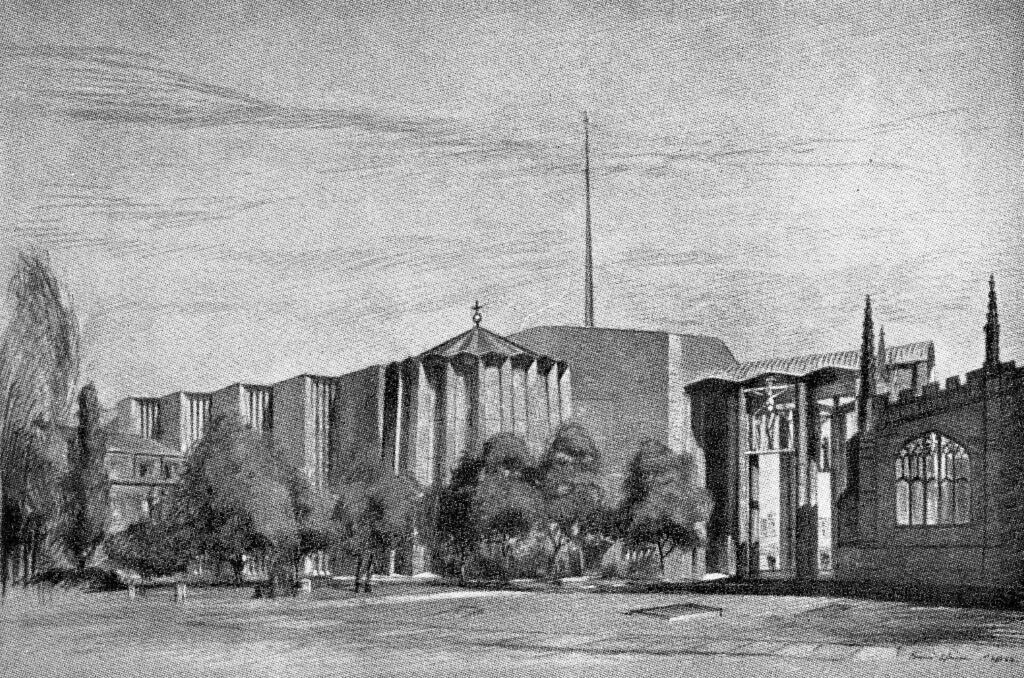
Once again, Christmas was very well celebrated—at least in Coventry. The shopkeepers reported a glut of spending with apparently no shortage of money.
Was it perhaps a repetition of the previous Christmas in that the people had decided to have a good time as a relief from—or in spite of—the gloominess of the general situation? For the Conservative Government had made no bones about the disastrous state in which they had found the country’s resources.
Cuts in imports and many austerity measures were promised in order to husband the country’s strength and, as though to emphasise the urgency of the situation, Mr. Churchill, without even waiting for the old year to die, flew, on December 31st, to America to consult with President Truman. On the same day it was announced that the price of coal was to be increased by 5/-per ton.
The epitaph of the passing year was pronounced by a local newspaper which said “Most of us will look back on 1951 as a disappointing and disastrous year”.
